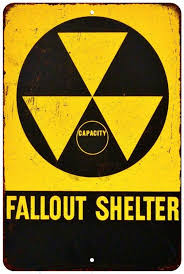"Shall we play a game?" says the War Operation Plan Response computer to Matthew Broderick's character in War Games. I was 22 years old when this movie came out and thought it was one of the most important I'd ever seen. I had grown up in the shadow of my own little desk as I dutifully "duck and cover" drilled, and in the shadow of the civil defense symbol on public buildings. By the time I was 8 I had figured out that global thermonuclear war is a game where the only winning move is not to play-- how hard would it be for our nation's leaders to come to the same resolution?
And yet, 38 years after that movie came out, 32 years after the fall of the Berlin Wall, 30 years after the dissolution of the Soviet Union, the US still holds 5,800 nuclear weapons, and missileers sit in underground bunkers all over the US awaiting the order that would release one or more of the nation's 450 ICBMs on a pathway to mutual assured destruction.
In 2008, Nathan Hodge and Sharon Weinberger set out on a road trip that turned into two years' worth of vacations spent in nuclear silos, radioactive wastelands, and hidden communities throughout the US and around the world. And they learned and saw with their own eyes that, ironically, military authorities and civilian communities alike depend on the maintenance, monitoring, testing and even manufacture of weapons of mass destruction for their daily livelihood, and that, therefore, the worldwide nuclear arsenal is not going anywhere.
Each chapter details a trip to a different site associated with nuclear weapons. Reading the whole book leaves one with the distinct feeling that the whole nuclear enterprise was and continues to be tinged with madness. In Nevada, the US "nuked its own territory nearly a thousand times to demonstrate to its adversaries the devastating strength of its arsenal." At Los Alamos, James Mercer-Smith, a thermonuclear weapons designer in a country that theoretically no longer makes nuclear weapons, talks about how much he loves the holes created by underground testing of his weapons. In labs like Livermore, the Reliable Replacement Warhead was being touted as the "responsible" way to continue mutual assured destruction-- but, you know, not at excessive levels. Just enough destruction to keep us safe.
In Tennessee, the authors went to Oak Ridge, a town created to be home to the Y-12 National Security Complex, where to this day you can attend job fairs to learn about exciting careers at a factory that has strikes, unions, safety procedures, and also Top Secret clearances and little things like 1800 grams of highly enriched uranium found in a 20-year-old air filter. Just another day on the factory floor. In Nebraska, visiting STRATCOM, the authors learned about "global strike," the new term of art for preemptive attack plans including nuclear weapons as just part of a standing strategy for launching a war of aggression. (Fun fact: the Air Force Global Strike Command, which includes ICBM and Air Force Nuclear Command forces, will be doing a flyover at this year's Superbowl! Yay!)
In Wyoming, a missileer named Lieutenant Strickland is asked how she feels about the 'pivotal key turn, the one task she will perform only once, if at all. "I've been doing this for two years," she said cheerfully, "and it makes me anxious every time." ' She works in a facility that was built for conditions that had already ceased to obtain by the time it was completed in 1965 and has become even more obsolete in light of the greatest threats actually facing the US today, foreign and domestic terrorism.
On the other hand, Site R, the mysterious "undisclosed location" facility everyone knows about just outside Gettysburg, is going strong and has been recommended not only by our authors, but (as one of the country's strangest military bases) by Popular Mechanics. I guess that's good news for the south-central PA economy?
Of course the fun doesn't stop in the US. The authors went to nuclear testing sites in Kazakhstan, where the biggest claim to fame is the deformities suffered by some residents; to Russian sites associated with the United State's 500-million-dollar effort to reduce the threat from that country; and to Iran to see the nothing-to-see-here locations where that country is building up its scientific and technical nuclear expertise while definitely of course not building any weapons. And after all of this, the authors are left asking:
Where was the debate over nuclear strategy? We had spent two years traveling the world to understand how nations view nuclear weapons. We came away less convinced than ever that there was any strategy to speak of.
It seems us cold-war kids are destined to live in that proverbial mushroom-cloud shadow all our lives. In the aftermath of the January 6 attack on the White House, Nancy Pelosi publicized her conversation with military authorities on the extent of outgoing President Trump's access to nuclear codes, giving voice to my own concerns if no one else's. The current issue of Wired features a story imagining global thermonuclear war between the US and China. As long as someone, somewhere thinks MAD is good sense, nobody's winning the arms race.

No comments:
Post a Comment